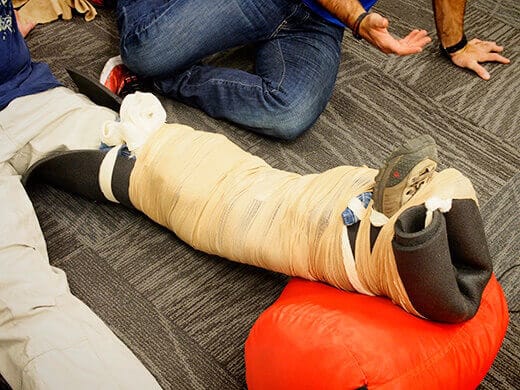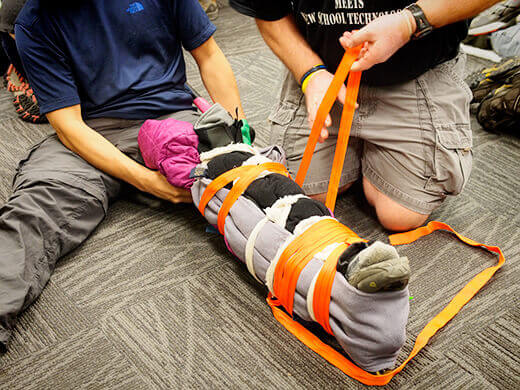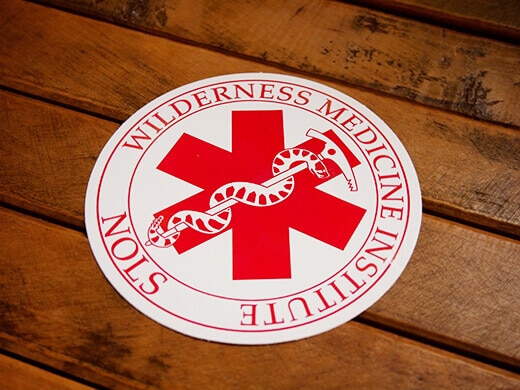Anyone who’s even just peeked at my blog knows that I’m an adventure addict. If you stepped inside my garage, you’d seriously think you were inside an REI store… Shelves and hooks full of climbing, camping and backpacking gear; bin after bin filled with watersports equipment; snowboards, downhill skis and cross-country skis leaning against the wall; surfboards of all sizes and a stand-up paddleboard hanging from the ceiling; kayaks sitting on the floor wherever there’s still space and my beach cruiser hiding in a back corner next to my husband’s project BMX bike. It really is astonishing how much can fit inside what’s essentially a one-car garage.
Though I’m a lover of the outdoors, it’s almost silly that I’ve continued to venture into the backcountry without any formal first aid training, save for what I’ve learned watching Bear Grylls (and yes, I know, he still has a camera crew out there to rescue him if shit really hit the fan).
I’d been wanting to take a course from the Wilderness Medicine Institute for a while, with one excuse after another for why I couldn’t attend (usually it involved me jetting off on another adventure the same weekend).
But last weekend, I was invited to audit a course offered by REI Outdoor School and I jumped at the chance to finally attend their two-day Wilderness First Aid program, taught in conjunction with WMI.
The class covered general training for in-the-field emergencies like bites and stings, sprains, fractures, dislocations, concussions, heat and cold injuries, altitude sickness, anaphylaxis, even unconscious hikers collapsed on the trail. A lot was packed over the course of two days and there was so much more I wanted to learn at the end of each day.

Wilderness medicine is different from urban medicine in that you’re forced to utilize the tools you have on you. There are no ambulances and no pharmacies; oftentimes in my case, the nearest help is hours away. You can only carry so much with you in a backcountry first aid kit, so you learn to improvise with what you have in your pack – trekking poles, T-shirts, even tampons.
We engaged in scenarios each day that allowed us to apply our new skills in a more realistic situation – a climber on Mount Whitney that was hit in the head with a rock, for instance. Or a hiker on Mount Wilson with a lower leg injury caused by a fall. We learned how to properly assess our patients and take actions to stabilize their conditions.
In one of the lessons, the instructors (who were both excellent) demonstrated a leg splint using a sleeping pad and ace bandages.

When it was our turn, I used my whitewater kayak paddle (which broke down into two pieces) and made a splint by padding it with under/outer layers and wrapping it with webbing — all things I usually carry in my pack. According to my “patient,” it was super bomber and he couldn’t move his leg at all!

Hopefully it’s not a skill I’ll have to put to use any time soon (or ever!), but it’s reassuring to know I can handle most emergencies in the wild when it comes down to it. As of last week, I am officially certified in wilderness medicine!
WMI’s Wilderness First Aid course is offered by REI Outdoor School several times a year in different cities. I highly recommend it for anyone who travels in the backcountry a handful of times a year. For lighter options, there are also things like map and compass classes and paddling excursions – including a guided kayak tour of my neighborhood around the Palos Verdes Peninsula. Maybe this winter you’ll want to try a new activity? (It also makes a great gift for an outdoor-loving friend!)
This post is brought to you by REI. Thank you for supporting the sponsors that support Garden Betty.
















I have taken the NOLS Wilderness First Aid class twice, once as part of a retreat for a wilderness group I’m part of, and the second time through REI. I think WFA is an important skill for backcountry people. However, the REI class was far inferior to my first class. The most important part of the course is the practice sessions, where students treat mock patients. With a ratio of 2 instructors for 30 students, the instructors were unable to monitor the students. I saw numerous mistakes. Without feedback the students kept making the same mistakes again and again.
Buyer beware: If you want to take Wilderness First Aid (and I hope you do), check out the student: teacher ratio before signing up. And probably avoid REI classes.
Since that was the only WFA class I took, I don’t have any others to compare it to, but I suppose everyone’s experience will be different based on the instructors they have. Both of my instructors at REI attended to every mock treatment scenario, gave ample feedback, and presented alternative solutions to the whole class as well. We learned from not only our own scenarios, but all the other students’ scenarios. So maybe it’s just luck of the draw, but I thought my instructors were excellent. (I also can’t remember how many students were in my class. Maybe 20?)
Get outside much? This is essential: A Weekend of Wilderness Medicine Training With REI Outdoor School http://t.co/bMTQeBvdCM #backcountry
I joined @REI for a crash course in safety. A Weekend of Wilderness Medicine Training With REI Outdoor School http://t.co/cPgc8es4Yy
Venture into the backcountry? You might need this: A Weekend of Wilderness Medicine Training With REI Outdoor School http://t.co/06xiUmTFmj
A Weekend of Wilderness Medicine Training With REI Outdoor School http://t.co/ElnmlyaIuX
Thanks @REI! A Weekend of Wilderness Medicine Training With REI Outdoor School http://t.co/ExJSV57Ecm #backcountry #firstaid
A Weekend of Wilderness Medicine Training With REI Outdoor School:
Anyone who’s even just peeked at my blog k… http://t.co/PuYxStvRSm
Blogged on Garden Betty: A Weekend of Wilderness Medicine Training With REI Outdoor School http://t.co/pvXnyl5ipA